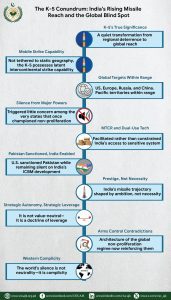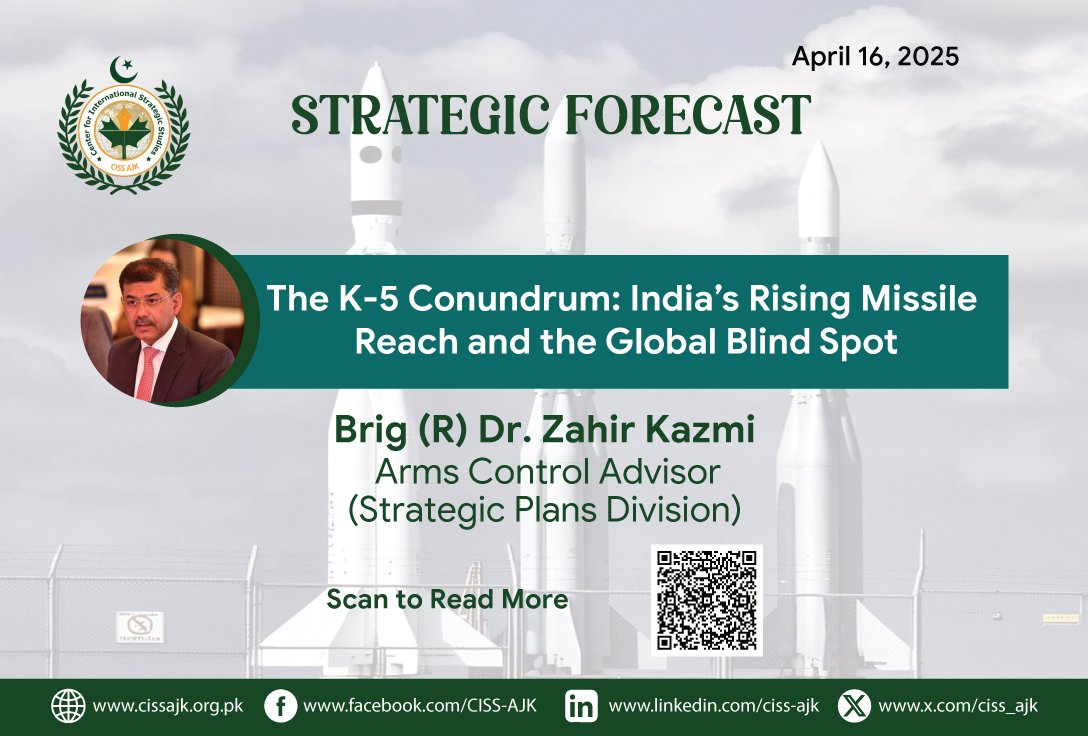 India’s upcoming K-5 Submarine-Launched Ballistic Missile (SLBM) is often presented as a technical milestone—another incremental step in its long-touted credible minimum deterrence posture. But the true significance of the K-5 lies not in its payload or platform alone. It marks a quiet transformation of India’s strategic arsenal from regional deterrence to global reach, from restraint to intercontinental ambition.
India’s upcoming K-5 Submarine-Launched Ballistic Missile (SLBM) is often presented as a technical milestone—another incremental step in its long-touted credible minimum deterrence posture. But the true significance of the K-5 lies not in its payload or platform alone. It marks a quiet transformation of India’s strategic arsenal from regional deterrence to global reach, from restraint to intercontinental ambition.
According to official narratives, the K-5 has a range between 5,000 and 8,000 kilometers, with launch assumptions anchored south of India’s Andaman Islands. But these estimates are misleading by design. SLBMs are not tethered to static geography. Once deployed on nuclear-powered submarines—like India’s Arihant-class or the larger S5-class under development—the K-5 can be launched from vast oceanic patrol zones, bringing not only China, but also Europe, Russia, and potentially U.S. Pacific territories within range. The missile’s mobility gives it latent intercontinental strike capability—without the political accountability that such a capability should demand.
Curiously, India’s quiet quest for global reach has triggered little concern among the very states that once championed non-proliferation. The United States, France, and Russia continue to deepen defense ties with India. The Missile Technology Control Regime (MTCR), to which India was admitted in 2016, has facilitated rather than constrained India’s access to sensitive propulsion and guidance systems. Dual-use cooperation with Israel, France, Russia, and the U.S. has powered India’s long-range missile and space programs. Meanwhile, India’s pursuit of hypersonic technologies and multiple independently targetable reentry vehicles (MIRVs) continues unabated.
Contrast this with how Pakistan is treated. In December 2024, the U.S. sanctioned Pakistani entities for alleged ballistic missile advancements—despite no evidence of an intercontinental missile program. Pakistan’s longest-range missile, the Shaheen-III is designed strictly to deter India and cover strategic assets like the Andaman and Nicobar Islands. No Pakistani system is capable of striking Europe or North America. Yet in the final days of the Biden administration, U.S. Deputy National Security Advisor Jon Finer publicly raised concerns about Pakistan’s “growing range,” while remaining conspicuously silent on India’s ongoing ICBM development.
This double standard is not just analytically flawed—it is geopolitically dangerous.
India’s missile trajectory has always been shaped by ambition, not necessity. Its nuclear program began well before China or Pakistan posed credible threats, and former Prime Minister I.K. Gujral once candidly admitted that India’s nuclear weapons were aimed at securing global status—not merely deterrence. Today, that status aspiration manifests as strategic autonomy—a concept often misunderstood as benign.
But strategic autonomy in India’s hands is not value-neutral. It is a doctrine of leverage, allowing New Delhi to simultaneously court Washington, maintain deep defense ties with Moscow, and preserve economic interdependence with Beijing. India refuses to take clear sides in the U.S.-China rivalry. It declined to join Western sanctions on Russia. And despite being called a “net security provider” in the Indo-Pacific, India is quietly building an arsenal that threatens not just regional but global capitals.
This fluid posture benefits India—but at growing cost to its partners. For the U.S., India’s hedging dilutes the credibility of its Indo-Pacific strategy. For Russia, India’s expanding missile range and deepening ties with NATO states present long-term risks. For Pakistan, India’s unchecked buildup reinforces strategic asymmetry, undermining the logic of deterrence and increasing crisis instability.
The architecture of the global non-proliferation regime—designed to limit precisely these trajectories—is now reinforcing them. India, despite remaining outside the Nuclear Non-Proliferation Treaty (NPT), enjoys waivers and access denied to Pakistan. It faces no constraints under U.S. export control regimes. It is rarely questioned about its SLBM deployments or space-to-missile crossovers. Instead, it is enabled—technically, diplomatically, and strategically.
This permissiveness is not sustainable.
India’s capabilities are evolving faster than the political narratives built to justify them. The K-5 and future systems like the Agni-VI and Surya missiles will complete India’s transformation into a state with global nuclear strike capability. Whether or not India chooses to weaponize this potential overtly, the capability itself will alter the strategic calculations of Russia, China, Europe, and the United States.
Moreover, the idea that a state can build ICBMs, MIRVs, ASAT weapons, and hypersonic missiles while maintaining doctrinal ambiguity should be alarming. India’s incredible posture—‘No First Use’ and ‘Credible Minimum Deterrence’—increasingly rings hollow amid weapon systems designed for first-strike resilience and global reach.
For Western policymakers, this calls for recalibration. If stability in South Asia—and indeed globally—is the objective, then strategic restraint cannot be demanded of one state and waived for another. Non-proliferation norms must be applied equitably. Technology transfers must be evaluated not by whom they benefit, but by what strategic behavior they reinforce.
For Russia, too, the time has come to reassess assumptions. India is no longer a passive buyer of Russian defense systems. It is becoming a peer competitor in some domains—and a potential vector of Western influence in others. Strategic ambiguity today may become strategic divergence tomorrow.
Finally, for Pakistan, this is not a moment of alarmism—but of clarity. Its missile program remains doctrinally India-centric, its deterrence posture transparent, and its restraint demonstrable. But to maintain credibility and avoid encirclement, Pakistan must continually articulate these positions forcefully—backed by fact, not rhetoric. It must expose the strategic contradictions in global arms control and assert its case as a responsible actor in an increasingly unstable regional matrix.
India’s rise is no longer a hypothetical. Its capabilities now reach far beyond its region. And the world’s silence is not neutrality—it is complicity.
⸻
Brig (R) Dr. Zahir Kazmi is Arms Control Advisor, former Director General of Arms Control and Disarmament Affairs at the Strategic Plans Division, and author of several works on strategic stability in South Asia. The views expressed are his own and do not necessarily reflect official policy.

